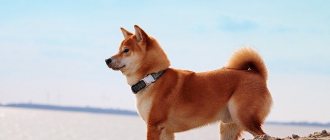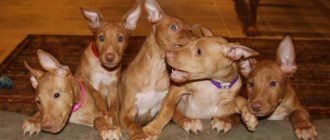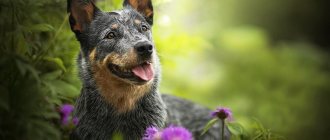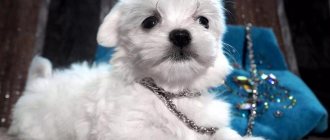| Breed name: | Basenji or African non-barking dog |
| Breed name in English: | Basenji |
| Country of origin: | Africa |
| Type: | Average dog |
| Weight: | 9-12 kilograms |
| Height (height at withers): | 38-43 centimeter |
| Color | Black, brown, white, red, tricolor, brindle |
| Wool length | Short |
| Lifespan: | 12-16 years old |
| Character | Smart, independent, loyal, curious |
| Number of puppies (average): | 2-3 |
| Price of puppies: | 400-1200$ |
Description
The Basenji (in English - Basenji) is one of the oldest dog breeds in the world. It was previously used for hunting in Central Africa. These dogs were known to people even before the pyramids were built. Many people say that the animal behaves like a cat because the breed is difficult to obey orders.
— Advertising —
Other names for the breed are the non-barking dog of Africa, the barkless African dog, and the Congo dog.
Dogs have become famous because they don't bark. Animals will express their feelings by making strange sounds. This dog has a unique temperament and personality. If you are planning to purchase a breed, it is recommended that you research its characteristics. Some people say they are ideal pets. Others note that they are impossible to cope with.
Advantages and disadvantages of the breed
Like any other Basenji breed, they have their advantages and disadvantages. The first include:
- Attachment to owners;
- Ability to learn;
- Cleanliness, no odor;
- Ability to get along with children;
- Lively and cheerful disposition.
The disadvantages are relative; some adore this breed precisely because of them:
- Require constant attention;
- They can run away;
- They do not tolerate loneliness;
- Quite capricious, sometimes refuse to follow commands;
- They are cunning and excellent at manipulating loving owners.
If your life style is peace and contemplation, and you don’t want to change anything, then you should choose a different breed of dog. But those who want to acquire a cheerful and restless friend, a companion for long walks, should pay attention to the Basenji.
Appearance
Breed standard: animal size is medium. The height of an adult male is about 43 centimeters, the female is about 40 centimeters. Males weigh about 11 kilograms, and females weigh about 10 kilograms.
— Advertising —
Exterior of the Basenji: This dog breed has thin bones and very high legs. She has a wrinkled head that stands proudly on a curved neck. The dog is always balanced, alert and intelligent.
Body: elegant, aristocratic.
Head: small, set high. The skull is flat. The muzzle tapers from the eyes to the nose. The cheeks are not prominent. There are wrinkles on the forehead.
Eyes: almond-shaped, slanted. The edges of the eyelids are dark. Eye color ranges from light gray to black, but more often dark brown.
Ears: straight, thin, small, slightly pointed. They are widely spaced, slightly tilted forward.
Chest: Deep. The ribs are well convex and oval.
Nose: black.
Teeth: strong jaws, scissor bite. The upper jaw fits tightly to the lower jaw.
Neck: strong, long, well set into the shoulders.
Back: straight and strong. The loin is short. The groin is pulled in. The tail is set high, tightly curled into a ring.
Forelegs: straight, thin, set moderately wide. The shoulders are oblique and muscular. The forearm is long.
Hindquarters: strong, muscular. The shins are long.
Feet: Small, narrow and compact. The pads are thick.
Coat: short, smooth, fine, lying close to the body.
The dog comes in different colors and patterns: black, chestnut, red, tricolor or trindle (chestnut and black) and brindle (chestnut with black stripes). Individuals may have white legs, chest and tail tip. This dog may have white spots on the neck or on the face between the eyes. However, white should not predominate in color.
Pros and cons of a dog
Characteristics of advantages:
- The pet is very smart, playful and energetic.
- The Basenji is loyal to its owners and shows great love to them.
- The animal has short hair, so it is easy to care for.
- The breed has almost no shedding.
- An extremely alert dog. He has excellent security abilities.
- The breed is hypoallergenic.
Characteristics of minuses:
- Your pet needs a high level of activity.
- The dog needs a sufficient amount of exercise and exercise so that it does not start destroying the house.
- He is suspicious of strangers.
- The pet may show aggression towards other animals.
- He will chase all moving objects and individuals.
- The dog has a wayward character.
Photo and video review
Before visiting the nursery, you should look at photos and videos featuring these cute, restless animals. If the future owner is the same active and cheerful person, then he and his pet will certainly become best friends.
History of the breed
The history of origin and legends say that this is the oldest breed of domesticated dogs. They were discovered in Congo (Africa) and were associated with people long before the pyramids were built. Hence its second name - African dog. The individuals are believed to have descended from Central African pariah dogs and were received as a gift from the pharaohs.
In some Mesopotamian and Babylonian drawings, the Basenji breed is clearly visible. Although these civilizations died out, the dogs probably survived as a semi-wild breed.
The animals were later discovered by inhabitants of western Congo in the 19th century. They were used to drive game into nets, carry goods, and warn people of the approach of any dangerous animal. Some tribes in Africa valued these dogs more than their wives.
Basenjis were brought to England in the 1890s. But soon, a distemper epidemic destroyed most of the breed. When a vaccine became available in the 1930s, Basenjis were returned to Britain and introduced to the United States.
The American Kennel Club fully recognized the breed in 1943. The first registered dog was Bois in 1944.
Reviews
Maria, Rostov-on-Don: “These dogs are excellent companions for both adults and children. Basenjis are playful, intelligent, active and at the same time so affectionate - just seeing them nearby makes you smile.”
Sergey, Volgograd: “The silent Basenji breed has a picky character. Their small size makes them easy to keep even in an apartment. Basenjis require constant training and movement.”
Anna, Voronezh: “Good, cheerful and active dogs. Very independent and smart. A huge plus is their cleanliness and ability to get along with the child. The only disadvantage I know of the Basenji breed so far is disobedience.”
Maintenance and care
You should not have any difficulties in maintaining and caring for this pet.
- Dogs' fur is short and thin. Brush your pets with a comb or comb once a week. Brushing will also distribute the body's natural oils, which will help keep the coat healthy and beautiful. This dog sheds like any other breed. But her hairs are short and therefore invisible.
- The animal will take care of itself in terms of cleanliness. It is constantly washed and cleaned. The pet does not smell like “dog” like some other breeds. If your pet is very dirty, wash it with warm water and a special shampoo.
- Brush your dog's teeth several times a week.
- Trim your pet's nails periodically at home or at the veterinarian. Do this every 2-3 weeks to prevent damage to your nails due to overgrowth.
- This active dog requires daily exercise. Otherwise, she may become bored, leading to destructive behavior in the house. Buy a harness for walking.
- Independent but affectionate, they are happy to live indoors with their owners.
- The animal thrives in climates where the temperature is not too hot and not too cold. For winter, buy a jumpsuit or sweater.
During grooming, check your dog for signs of rashes, sores or other infections. If you check your pet regularly, you can detect and prevent some potential health problems.
Mating
- The female's first estrus occurs at the age of 1-1.5 years , from this moment the owner must keep a diary, noting the frequency and duration of each period of sexual heat.
- Dogs can be mated starting from their second heat, but only if the bitch does not have infectious or inflammatory diseases.
- Before mating, the dog needs to be dewormed. For a better pregnancy, it is necessary to follow the vaccination schedule.
- The dog should not be too thin or fat.
- The male and female must know each other before mating, and the reaction of the pets to each other must be observed. The female must be friendly towards the male, otherwise during the period of estrus she will react aggressively and may bite.
- It is advisable to conduct mating on the male’s territory so that the dog feels more confident.
- If the mating is carried out on the territory of the bitch, she may react to the male with hostility, as if he were an invader of the territory.
- Mating occurs like other dogs. Before mating, an agreement is concluded between the owners in which all conditions are discussed.
- If you have health problems, you should contact your veterinarian.
- Pregnancy lasts 63 days . There are usually 4-5 puppies in a litter.
Nutrition
Many owners don’t know what and how to feed their dog? Avoid feeding table scraps and people food. This can instill in them the habit of begging and can also lead to weight gain and health problems.
It should be noted that the amount of food you feed depends on the size, weight, age, build, metabolism and activity level of your dog. Make sure you know your animal's individual needs.
A balanced diet contributes to a healthy lifestyle and growth of your pet. Here are the necessary food components:
- Protein is the main building material for tissues, cells, organs, hormones, antibodies and enzymes. It is also important for maintenance, repair, growth and reproduction. Pets need 30% protein in their diet.
- Fat is an important source of energy. It provides twice as much energy as proteins and carbohydrates. Too much fat is not healthy. 5% of the total diet will be enough.
- Carbohydrates are also another source of energy. Carbohydrates are found in cereals.
- Vitamins are essential for the normal metabolic functioning of your dog's body. You can additionally purchase vitamin supplements.
- Minerals are important for growth, strong bones, teeth and fluid balance.
Never give your pet:
- Grapes or raisins.
- Chocolate candies.
- Yeast dough.
- Very salty food.
- Onion.
- Garlic.
These products can cause poisoning.
The approximate amount of food that adults need depending on activity:
- With a weight of 9.5 kg, give from 95 to 159 g.
- With a weight of 10 kg - from 135 to 206 g.
- With a weight of 11 kg - from 145 to 216 g.
- With a weight of 12 kg - from 155 to 226 g.
Feed an adult dog 1 or 2 times a day. Do this at approximately the same time.
Why doesn't the Basenji eat? This may be due to the following reasons:
- Environmental changes.
- Changing your feeding schedule.
- Changes in food or feed.
- Dental problems.
- Recent vaccination.
- Pickiness.
If your pet does not eat for more than a day, seek help from a specialist.
Price and choice of Basenji puppy
The baby is purchased only in a specialized nursery. Dogs purchased through an advertisement or secondhand may have health and mental problems. They do not have documents confirming their breed. Such a puppy is a Basenji phenotype and is not allowed for further exhibitions or breeding.
When choosing a nursery, you should definitely check information about it on breed forums. Cases of fake puppy cards have become more frequent: the stamp of the “left” kennel is placed on the tear-off coupon; its name does not correspond to that indicated in the prefix to the puppy’s name. The parents' pedigree numbers look strange. The data on the brand does not coincide with the specifics of its numbering relating to the breed. Below are the names of trusted nurseries where you should purchase a puppy.
The cost of a good baby starts from 50,000 rubles. It all depends on the ancestors behind it: the higher their breeding value, the more expensive the dog will be.
Nicknames
For boy
Popular nicknames for boys and their meaning:
- Winston (“joyful”)
- Ayo (“full of joy”)
- Jabari ("unique").
- Dakari (“happiness”).
- Amra ("unique").
- Yapo (“tested”)
- Leki ("younger brother").
- Albert ("noble").
- Ippy (“proud”)
- Dakari ("full of joy")
- Damasi ("cheerful personality").
- Grigor ("vigilant").
- Kayan ("widely recognized").
- Jack (“God Given”)
- Russell ("smart")
For girl
You can name girls with the following names:
- Asha ("living").
- Alaya (“joyful”, “happy”).
- Makena (“full of delight”)
- Mona ("unique").
- Aira (“vigilant”).
- Fahima (“with great intelligence”).
- Beatrice ("bringer of joy")
- Grizzily ("who has a keen mind").
- Elekta (“unique”)
- Sana ("shiny")
- Yeshe (“energy”, “life”).
- Sanura (“smart”).
- Elin (“intelligence warrior”).
- Ossi (“happy”)
Breeding
Girls come into heat at the age of 7-8 months. It is noteworthy that in this breed it occurs only once a year: in the autumn-winter period. Therefore, the easiest time to buy a puppy is in the spring. Dogs are bred when they reach the age of one and a half years.
Mating is planned in advance. Both parents are prepared for it: they check their health, feed them a balanced protein diet, and introduce them to each other.
The female's pregnancy lasts 56-73 days. Signs of pregnancy appear towards the end of the first month. These include pet lethargy, drowsiness, but good appetite. Be sure to feed your dog high-quality food that is rich in vitamins and minerals.
Ensure that a veterinarian is present at the birth. Especially if they are the first. A specialist will help in case of unforeseen circumstances.
Normally, 2-3 puppies are born. Although there have been cases when 10 babies were born at one time.
Who is the Basenji suitable for?
Puppies
The average cost of a Basenji puppy is $800. If his parents have a good pedigree, the price of the baby will be higher.
The average weight of puppies varies depending on age:
| Age, months | Weight, kilogram |
| 1 | 1,4 |
| 2 | 2,8 |
| 3 | 4,3 |
| 4 | 5,8 |
| 5 | 7 |
| 6 | 7,8 |
| 9 | 9,4 |
| 12 | 10 |
Don't forget to vaccinate your pets according to the schedule.
How to feed Basenji puppies?
A balanced diet is vital to your dog's growth and health, and portion control is key.
Many commercial pet foods are excellent choices. However, be sure to read the label before purchasing. The food should contain the following:
- Good balance of meat, vegetables/or fruits.
- Meat should be listed first.
- Do not take food containing meat by-products.
Feed puppies approximately the following amounts of food daily based on age:
- 2 months – from 41 to 92 g.
- 3 months – from 50 to 119 g.
- 4 months – from 53 to 140 g.
- 5 months – from 53 to 143 g.
- 6 months – from 56 to 143 g.
- 7 months – from 45 to 124 g.
- 8 months – from 40 to 106 g.
- 9 months – from 35 to 89 g.
- 10 months – from 32 to 88 g.
Number of meals per day:
- From 8 to 12 weeks of age, feed babies 4 times a day.
- From three to six months - three times a day.
- From 6 months to 1 year - twice a day.
- After 1 year, 1 or 2 meals every 24 hours is sufficient. It depends on the build and activity of your pet.
Puppies tend to become very close to one person or family. However, it is important to socialize your baby so that he can learn to get along with other people. Introduce your pet to neighbors and relatives, and take him to parks and stores.
Start training your puppy right away. He must know what is possible and what is not. You should also immediately take steps to stop your baby from biting.
Walk with your pet at least 2 times a day.
Photos of the puppies are presented below.
Features of feeding and diet
It is impossible to maintain good health for your pet without a properly organized and balanced diet.
It is important to maintain a balance between tasty and healthy in your pet’s menu. It is worthwhile to diversify it from time to time. The diet should be based on protein. Meat products should be low-fat; cartilage and offal can be used. It is useful to include vegetables and fruits in the Basenji's menu. Fish is also healthy, but only sea fish and low-bone fish when boiled. Recommended cereals are rice, buckwheat and oatmeal. You need to give pearl barley with caution, as it clogs the intestines.
Dry food can be used, but it must be at least premium and contain all the necessary vitamins and mineral compounds.
The owner decides what to feed the pet, but feeding twice a day is considered the norm for an adult pet. The bowl should remain empty after feeding. We must not forget about clean water, which is necessary for proper digestion.
From the age of one month, puppies should be fed fermented milk products, cottage cheese, raw quail eggs, oatmeal with the addition of grated carrots. Such food guarantees the presence of useful elements in the baby’s diet.
It is not recommended for an animal of any age to give treats from the owner’s table. Basenjis are strictly prohibited:
- sweets and chocolate;
- flour;
- spicy or salty foods;
- fish and tubular bones.
You should not overfeed your pet. A slight feeling of hunger should always be present in a healthy individual to maintain its activity.
Dog character
This is a species that was formed in the wild, so the dogs are accustomed to independence.
The breed is smart, a little stubborn, funny, and also affectionate towards its owners. The animal does not bark. The animal usually speaks by screaming, screaming or other strange sounds. You will love his "screaming voice" when he is happy.
Dogs won't follow you around as they usually have their own plans. Pets can be a bit aggressive and destroy the house if they are not given enough activity.
The Basenji is better suited to families with older children who understand how to handle them properly. They are also excellent watchdogs.
Training this intelligent dog should be made up of short and entertaining sessions. It is important to use reward methods by periodically giving your pet treats.
A dog gets along with other pets (even cats) if it is trained and raised with them. If not, it is important to keep the breed away from small animals as it will chase anything that runs away.
Dogs love to sleep in a ball next to them on the sofa or directly on their owner. This will happen constantly on cold winter evenings.
Character of the Basenji breed
Basenjis are pack dogs that get along well with their relatives, but do not like other animals. Sociable, very smart, they can become a devoted friend and companion for a person. They choose the owner once, and they miss him very much. It is not recommended to leave Basenjis alone at home, especially during puppyhood. Prolonged loneliness can result in destructive behavior.
The Congo Terrier becomes attached to all family members. He loves to be the center of attention and demands to be played with. But he does not impose himself, although he is capable of being offended. This breed should be owned by someone who can pay enough attention to the pet, play and walk with it. Otherwise, the dog will grow up stubborn, uncontrollable and aggressive.
Basenjis are wary of strangers. They do not show aggression, but are able to fight back and protect the owner. Fearless, they can engage in battle with an opponent much larger and stronger than themselves. Relationships with children are difficult. The dog loves them, is ready to protect them as members of his pack, and supports them in games. But she can hardly tolerate pranks and rough treatment. These dogs have the following character traits:
- independent;
- independent;
- stubborn;
- affectionate;
- sociable;
- smart;
- fearless;
- active;
- good-natured;
- cheerful.
Education and training
Representatives of this breed are very intelligent, but they are difficult to train. Therefore, it is recommended only for experienced dog breeders to own one. Basenjis are independent, self-confident, and capable of making independent decisions. They understand words, know what their owner wants from them, but are in no hurry to carry out commands. This can be explained by the fact that since ancient times, dogs have become accustomed to obeying instincts and acting without human help. You can achieve obedience, but you need to find a common language with your pet and win his trust.
It is important to become a leader for the dog, only then will he respond to orders. You need to act patiently and kindly. It is impossible to force him to do anything. He will not do anything that is not interesting to him. Although these dogs are active and agile, it is impossible to teach them tricks or dog sports. Education must begin at an early age. Even the puppy shows autonomy and independence. Therefore, from the first day of his appearance in the house, you need to ensure that the basic commands are executed: “come to me”, “place”, “you can’t”, “sit”.
Must be kept on a leash while walking. Due to hunting instincts, the Basenji may chase a cat or bird or run out onto the road. In this state, he does not hear the owner’s commands. Therefore, first of all, you need to develop the ability to come on command and know your name. You also need to teach your pet to give food out of its mouth, let a person go forward, and give way. The dog must not sleep on the bed, growl and snap at its owner, or beg for food. When training, it is necessary to take into account the characteristics of the breed. Dog handlers give the following recommendations:
- you need to be fair, consistent and persistent;
- practice skills and commands regularly, regardless of the circumstances;
- always reward for correct behavior, do not skimp on praise and treats;
- the dog should like to be near the owner, you need to interest him;
- unacceptable behavior should be immediately punished, but physical force should not be used;
- The Basenji should not be bored; he needs physical activity and intellectual exercise.
The video will help you understand how to properly train these dogs and communicate with them:
Video: Basenji. Training and raising a dog
Education and training
The dogs were bred for hunting purposes and have a rather capricious nature. The Basenji can be stubborn and easily lose interest when it comes to training. They often have little desire to please people. In this case, you need to have a lot of patience.
They train best with kindness and consistency and a good reward system. This helps make training as interesting as possible for the dogs. A harsh or negative attitude during training will almost always backfire.
It is recommended that you start training and training your animals from the moment you bring them home. The main thing is to be patient and consistent.
Teach your pet the following first words and commands:
- Sit.
- It is forbidden.
- Lie.
- Take.
- Place.
It is also highly recommended that you socialize your Basenji from a young age. He must get used to the company of other dogs and people. Not socializing can cause dogs to be timid and sensitive.
Key points in training
- Basenjis enjoy training in the form of a game. Reward in the form of treats is also important for the dog.
- The dog may refuse to carry out monotonous and uninteresting commands.
- Being intelligent and independent, the dog will not tolerate violence or raising its voice.
- The main difficulty in training is establishing contact between the dog and the owner.
- If the right attitude is not developed, the dog will allow itself to show disobedience and may even growl at its owner.
- The relationship between your pet and other dogs should be properly built to prevent fights between animals.
Read about how to properly train a dog in the article: “Training a puppy: effective methods from dog handlers, learning commands at home.”
Why don't they bark?
The Basenji is the only dog that does not bark. Why can't they bark? This is due to the fact that the breed has a flat larynx. If you think that this is a silent pet, this is not true at all. The peculiar “barking” of dogs varies from cheerful sounds called yodeling to mesmerizing screams. They growl, whine and whine, howl, and sing, just like other dogs. Sometimes it's impossible to listen to.
Caring for the Basenji
Proper care of the Basenji, first of all, comes down to allowing the dog to run. Running is life for a dog. Pets are born runners and are happy to indulge in such an activity.
Basenjis are distinguished by lightning speed and increased energy. Confining a dog in a confined space will have an extremely negative impact - the dog will lose heart and cease to be a full-fledged carrier of genes.
It is strictly forbidden to bathe Basenjis - dogs cannot tolerate water and avoid it. Researchers believe the reasons lie in a genetic fear of crocodiles. You cannot force a dog to swim. If it is necessary to cleanse the skin, it is recommended to wipe it with a damp towel. Grooming is extremely simple; the hair requires only periodic combing of dead hairs. It is much more important to take care of the physical component and keep the dog free, giving it a chance to run around and lead an active lifestyle.
It is permissible to periodically massage your exquisite pet using a massage mitten, promoting blood flow and speedy renewal of the coat. It is prescribed to take care of the ears and teeth, as required by the norms and rules of hygiene.
Diseases
Basenjis, like all breeds, are susceptible to certain diseases. Some of them are common to dogs and occur frequently in all species. And others can be serious and genetic.
Common problems:
- Dental diseases.
- Infections.
- Parasites.
- Obesity or obesity.
- Allergy.
- Umbilical hernia.
Description of genetic diseases to which the Basenji breed is predisposed:
- Stones in the bladder or kidneys. There are several different types of stones that can form in the kidneys or bladder. If your pet has blood in his urine or is unable or unwilling to urinate, he needs emergency medical attention.
- Fanconi syndrome. This is a kidney disease that washes vital nutrients from the blood into the urine. Symptoms: excessive urination, thirst, weight loss, weakness. They usually appear between the ages of two and six years. The severity and course of the disease varies among individuals. Routine urine screening can help diagnose Fanconi syndrome in the early stages. Prompt treatment significantly increases the length and quality of life of your pet.
- Dysplasia of the hip and elbow joints. Your pet's hips and elbows are at risk for dysplasia. This is an inherited disease that causes abnormal joint development and leads to arthritis. If symptoms of lameness occur, consult a specialist immediately. The best treatment for this condition is surgery.
- Demodex. This is a microscopic mite that lives in hair follicles. All dogs have this tick. In mild cases, owners may notice a few dry, irritated patches on the pet's body, as well as dandruff. Subsequently, secondary skin infections may occur. If your dog is constantly itching, he needs help. Prompt veterinary care is important to prevent the disease from getting out of control. Some pets quickly get rid of this problem, but for others it becomes a chronic disease.
- Epilepsy. Epilepsy in animals manifests itself in the form of seizures. Today, there are three types of seizures in dogs: reactive, secondary and primary. Reactive seizures are caused by the brain's response to metabolic problems (low blood sugar, organ failure, toxins). Secondary seizures are the result of a brain tumor, stroke, or injury. If no other cause is found, the disease is called primary or idiopathic epilepsy. This problem is often an inherited condition in Basenjis. Seizures usually begin between the ages of six months and three years. An initial diagnosis can help find the cause. Lifelong drug treatment helps control seizures.
Health and treatment
The Basenji breed has good immunity and excellent health. But due to the characteristics of the species, dogs are prone to the following diseases:
- hip dysplasia;
- umbilical hernia;
- autoimmune anemia;
- thyroid dysfunction;
- problems with the gastrointestinal tract;
- retinal atrophy and other eye diseases;
- Fanconi syndrome (kidney pathology).
?
Fanconi syndrome is considered rare, but for some reason it is the Egyptian Basenji breed that is most susceptible to it. Since 1976, geneticists have been trying to identify the causes of this disease, but so far to no avail. Unfortunately, no animal is immune from it, so it is strongly recommended to have your dog examined every 6 months. The first bad signs are uncontrollable thirst and drinking, weight loss, rapid dehydration, and frequent urination.
Interesting Facts
- Dogs have been around for a very long time, as evidenced by Egyptian myths. The first illustration of the breed was found in the tombs of the Great Pyramid of Khufu. Pictures of pets are depicted on billboards and walls. There are even some mummified Basenjis.
- The Metropolitan Museum of Art in New York has a Babylonian bronze statue of the Basenji and his owner.
- The breed is classified as a size 30 animal. This is evidenced by the girth of the neck and chest: 28-30 centimeters and 40-44 centimeters, respectively.
- In Kenya, the animals are used to lure lions out of their caves. Hunters take about four dogs at a time to find lions and drag them outside.
- People in the Ituri rainforest called these animals "basenchi", which means "small bush".
- This breed got its name around 1936 from an English resident, Mrs. Burn.
- In earlier times, Basenjis were considered a royal gift.
- Like greyhounds and hounds, they use a double gallop when running. When most dogs run, at least one foot touches the ground. But in galloping breeds such as the Basenji, there are two distinct times when all four paws are off the ground. This feature helps the dog achieve impressive speeds.
- Pets keep their fur and paws clean on their own, just like cats. Therefore, they are easy to care for.
- These animals may be afraid of the dark.
- Some people do not know that the emphasis in the name of the breed should be placed on the first syllable - bAsenji.
- If you want to choose a quiet and almost voiceless dog, also consider breeds such as the American Akita and Shiba Inu.
- If you dream about a Basenji, expect to hear from your friend.
History of the origin of the African dog
The history of the Basenji is still a mystery to modern researchers, because these cute hunting dogs are no less than 5,000 years old. And although their homeland is considered mainly to be the Central African region, in the epicenter of which the state of Congo is located, portraits and sculptural figurines of dogs very similar to Basenji, as well as their mummies, are still discovered by archaeologists quite far from Congo, in the burial places of pharaohs and priests Ancient Egypt. And this is not surprising; historians and Egyptologists know that Congolese dogs were brought to Egypt not only for hunting, but also as amulets as gifts for the nobility.
However, the historical African homeland of the animal still declares itself through the existing abundance of breed names that geographically indicate the origin of the Basenji. These are: “bush Congo dog”; "Congo Terrier"; "Congolese terrier" and "forest dog from the Congo". In addition to these names, Basenji dogs are often called “Bongo” or “Zande dogs” (after the name of the Central African people living in the Congo, the Central African Republic and Sudan). Or even much more sonorous and even funny-exotic - “nyam-nyam terrier.” And in a very native way - “jumping up and down” (“Mbwa Mkubwa Mbwa”).
However, despite such an abundance of names, no one knows the true origin of the handsome Basenji. The first European to become acquainted with the hunting dogs of the Sande tribes was the famous German traveler and explorer Georg August Schweinfurth. Traveling in 1863–1866 with ivory buyers through the territory of South Sudan and the Congo, he noticed a large number of wooden figurines of dogs hanging above the huts, as well as the unusually silent dogs themselves with bells around their necks. As the natives explained to the traveler, the bells were needed in order not to lose this incredibly valuable “silent dog” in the tall grass of the savannah. Schweinfurt called the discovered dogs "Congolese terriers", fully describing their appearance in his diary.
The next European to personally become acquainted with the Basenji was the English traveler and explorer of Africa Sir Harry Hamilton Johnston. During an expedition along the Congo River in 1882, he, like Schweinfurt, discovered unexpectedly silent dogs among local tribes. Being also a talented photographer and artist, he not only described the exterior of his find in his diary, but also took a number of photographs and sketches, subsequently exhibiting them at the Royal Academy of Arts in London. This is how residents of Great Britain and other countries were able to see Basenji dogs for the first time in all their pristine glory.
In 1895, the first pair of Basenji dogs set foot on the shores of Foggy Albion. They were brought by Briton James Garrow. True, these dogs survived the long sea voyage rather poorly, and soon died of distemper. All further attempts to adapt the brought Basenjis to the climatic conditions of Great Britain also ended unsuccessfully. These animals were completely unsuited to the damp, cold climate of the British Isles, as well as a number of local canine diseases to which they had no immunity. But in the zoos of Germany and France (where they were brought in 1905 as exotic animals of Africa), Basenjis felt surprisingly well.
- Dog
- Long-eared cats
- Cat meowing
- Alexandrian parrot
- Why does a cat need a mustache?
- Rescue dogs
And only in the 30s of the 20th century, the English pioneer breeders of African Congo Terriers finally managed to overcome all the difficulties of adaptation of animals, their strange intolerance to vaccinations, and began breeding Basenjis in Great Britain.
In 1937, thanks to the many years of efforts of dog breeder Olivia Burn, the Basenji breed was officially included in the British Stud Book. That same year, unusual silent dogs were presented by Olivia Barn at the Kraft exhibition, causing considerable excitement among the public who wanted to see for themselves that the “jungle dog” did not actually bark.
After such a surge in interest, the new breed also became interested in Americans. And soon (approximately in the same 1937) Congo terriers were brought to the USA, and in 1942 they were registered with the American Kennel Club (AKC).
In 1939, the first Basenji club was created in Great Britain. In subsequent years, the Second World War prevented the further development and spread of the breed in Great Britain. But by 1947, Congolese terriers had not only restored their former positions, but also gained world championship titles. And they were even presented to King Farokh of Egypt (at that time Egypt was still a monarchy) during a visit to Great Britain as a gift. The dog, which for many millennia was previously the “guardian of the pharaohs,” has again returned to its ancient duties in relation to the Egyptian monarchs.
In 1964, the Congolese Bush Dog was recognized by the Fédération Cynologique Internationale, taking its place in the group of Spitz and primitive dogs.











